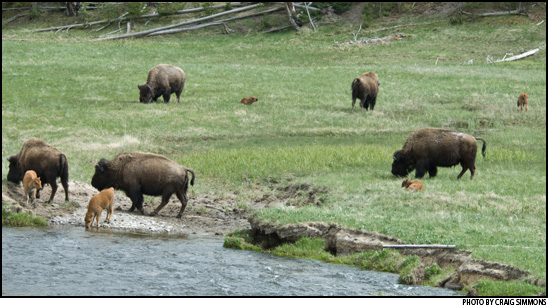HEALTH & NUTRITION...

Wildlife Diseases Still a Concern
University of Wyoming Dean provided update on CWD, brucellosis.
Frank Galey, dean of the University of Wyoming College of Agriculture and Natural Resources, provided an update on animal disease issues Dec. 1 in the opening session of the 2009 Range Beef Cow Symposium in Casper, Wyo. Galey focused primarily on chronic wasting disease (CWD) and brucellosis, the threat each poses to wildlife or domestic livestock, and respective management efforts.
Despite environmental activist groups' claims to the contrary, University of Wyoming Dean Frank Galey said there is solid evidence that brucellosis is being transmitted from elk to cattle. With regard to CWD, Galey said surveillance of Wyoming cervidae (deer and elk) continues, and some new cases have been reported in the state. As with bovine spongiform encephalopathy (BSE) in cattle, the causative agent for CWD is an infectious protein particle (prion) that attacks the central nervous system of cervidae. Read more.

Bob Larson
Vet Link
Polio due to sulfur toxicity
Polioencephalomalacia (commonly called polio) in cattle is due to brain damage that can be caused by a number of things, including lead toxicity, salt toxicity or thiamine deficiency.
I see several cases a year of polio caused by high levels of sulfur (S) in the diet. Cattle with polio, regardless of the cause, may have aimless wandering, indications of blindness, head-pressing, stumbling, circling, muscle tremors and possibly convulsions. Polio due to sulfur toxicity is usually seen at least one to three weeks after first starting animals on a diet high in sulfur. Read more.
Use Caution When Grazing Cornstalks,
Feeding Baled Cornstalks
The unusually wet fall and late harvest have resulted in mold and fungi in corn and cornstalks. Producers have asked about feeding the moldy corn grain, baled cornstalks and grazing cornstalks to cattle. The answer is not simple because mold does not always result in mycotoxins, and not all mycotoxins are harmful to cattle, according to Amy Radunz, University of Wisconsin Extension beef specialist.
Generally, cattle are more tolerant of mycotoxins than other livestock; however, this fall more caution may be warranted, Radunz noted. Read more.

Rick Rasby
Ridin’ Herd
Keep heifer development cost affordable.
Heifer development programs can be a major expense for the cow-calf enterprise. Heifer development costs will depend on when the potential replacements are weaned and the feeding strategy used to develop them. Read more.
Retained Placenta
According to veterinarian Dick Fredrickson of Grandview, Idaho, the main reasons for retained placenta are nutritional (deficiencies in protein, energy or certain trace minerals) and premature births.
"Cows that have twins or abort almost always retain the placenta," he says. "Occasionally it's simply a mechanical problem. The placenta gets hung up on a caruncle," he says, referring to the maternal site of attachment for the cotyledon. "Sometimes a thin cow or one that's overly fat may be more apt to retain the placenta."
Regarding treatment, oxytocin can be helpful if given in the first few hours, Fredrickson says. "This will stimulate more contraction of the uterus (which helps in the detachment process), but after 6 to 8 hours there's no beneficial effect from oxytocin because of the change in hormonal levels in the uterus. After that, Lutalyse® is the drug of choice, especially if the cow has retained the placenta for a day or more."
Fredrickson says some ranchers give tetracyclines or penicillin to head off possible infection. Most instances of retained placenta do not lead to serious infection, however. Unless the cow becomes dull, goes off feed or has a fever, antibiotics are usually unnecessary. The cow will generally go ahead and clean within seven to 10 days.
Septicemia in Calves
Occasionally, a calf suffers systemic infection in which bacteria or their toxins circulate through the blood stream, causing septicemia. This blood-borne infection may be immediately life-threatening, or localize anywhere in the body and cause abscesses in organs or septic arthritis in joints ("joint ill").
Veterinarian Dick Fredrickson of Grandview, Idaho, says these infections may originate via the navel stump in a newborn, or from ingested pathogens via the digestive tract (bacteria or their toxins that go through the gut lining into the circulatory system) or the lungs (pneumonia that progresses into septicemia).
"Calves that have adequate passive immunity (antibodies via colostrum) are less likely to develop septicemia than calves who don't receive adequate colostrum in a timely manner. Sanitation in calving areas and nutrition of the dam are big factors. If the cow has adequate protein and trace minerals, she can create better colostrum than a cow that's nutritionally deficient," he says.
Calves that receive adequate colostrum stay healthier all through the nursing and weaning period. "I've been a veterinarian at Simplot feedlots for 22 years, and we wean between 25,000 to 30,000 calves per year. We can trace most calves back to their source, especially the ones raised at Simplot ranches. The cow herd's nutrition and trace minerals are key for health of the calves," Fredrickson says.
New Vaccines May Help Thwart E. coli O157:H7
Immunizing calves with either of two forms of a vaccine newly developed by Agricultural Research Service (ARS) scientists might reduce the spread of sometimes deadly Escherichia coli O157:H7 bacteria. The microbe can flourish in the animals' digestive tracts, yet doesn't cause them to show clinical symptoms of illness. In humans, however, E. coli can cause bouts of diarrhea and, sometimes, life-threatening hemolytic uremic syndrome.
Research microbiologists Vijay Sharma and Thomas Casey developed the novel vaccines in their laboratories at the agency's National Animal Disease Center (NADC) in Ames, Iowa, and are seeking a patent for it. Read more.
Cattle Diseases: Common Conditions/Terms
Click here for a list of common conditions and terms related to beef cattle diseases, such as anaplasmosis, brucellosis, BVD, E. coli, IBR and others.
[Click here to go to the top of the page.]





